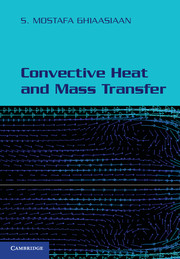Book contents
- Frontmatter
- Contents
- Preface
- Frequently Used Notation
- 1 Thermophysical and Transport Fundamentals
- 2 Boundary Layers
- 3 External Laminar Flow: Similarity Solutions for Forced Laminar Boundary Layers
- 4 Internal Laminar Flow
- 5 Integral Methods
- 6 Fundamentals of Turbulence and External Turbulent Flow
- 7 Internal Turbulent Flow
- 8 Effect of Transpiration on Friction, Heat, and Mass Transfer
- 9 Analogy Among Momentum, Heat, and Mass Transfer
- 10 Natural Convection
- 11 Mixed Convection
- 12 Turbulence Models
- 13 Flow and Heat Transfer in Miniature Flow Passages
- APPENDIX A Constitutive Relations in Polar Cylindrical and Spherical Coordinates
- APPENDIX B Mass Continuity and Newtonian Incompressible Fluid Equations of Motion in Polar Cylindrical and Spherical Coordinates
- APPENDIX C Energy Conservation Equations in Polar Cylindrical and Spherical Coordinates for Incompressible Fluids With Constant Thermal Conductivity
- APPENDIX D Mass-Species Conservation Equations in Polar Cylindrical and Spherical Coordinates for Incompressible Fluids
- APPENDIX E Thermodynamic Properties of Saturated Water and Steam
- APPENDIX F Transport Properties of Saturated Water and Steam
- APPENDIX G Properties of Selected Ideal Gases at 1 Atmosphere
- APPENDIX H Binary Diffusion Coefficients of Selected Gases in Air at 1 Atmosphere
- APPENDIX I Henry's Constant, in bars, of Dilute Aqueous Solutions of Selected Substances at Moderate Pressures
- APPENDIX J Diffusion Coefficients of Selected Substances in Water at Infinite Dilution at 25°C
- APPENDIX K Lennard–Jones Potential Model Constants for Selected Molecules
- APPENDIX L Collision Integrals for the Lennard–Jones Potential Model
- APPENDIX M Some RANS-Type Turbulence Models
- APPENDIX N Physical Constants
- APPENDIX O Unit Conversions
- APPENDIX P Summary of Important Dimensionless Numbers
- APPENDIX Q Summary of Some Useful Heat Transfer and Friction-Factor Correlations
- References
- Index
9 - Analogy Among Momentum, Heat, and Mass Transfer
- Frontmatter
- Contents
- Preface
- Frequently Used Notation
- 1 Thermophysical and Transport Fundamentals
- 2 Boundary Layers
- 3 External Laminar Flow: Similarity Solutions for Forced Laminar Boundary Layers
- 4 Internal Laminar Flow
- 5 Integral Methods
- 6 Fundamentals of Turbulence and External Turbulent Flow
- 7 Internal Turbulent Flow
- 8 Effect of Transpiration on Friction, Heat, and Mass Transfer
- 9 Analogy Among Momentum, Heat, and Mass Transfer
- 10 Natural Convection
- 11 Mixed Convection
- 12 Turbulence Models
- 13 Flow and Heat Transfer in Miniature Flow Passages
- APPENDIX A Constitutive Relations in Polar Cylindrical and Spherical Coordinates
- APPENDIX B Mass Continuity and Newtonian Incompressible Fluid Equations of Motion in Polar Cylindrical and Spherical Coordinates
- APPENDIX C Energy Conservation Equations in Polar Cylindrical and Spherical Coordinates for Incompressible Fluids With Constant Thermal Conductivity
- APPENDIX D Mass-Species Conservation Equations in Polar Cylindrical and Spherical Coordinates for Incompressible Fluids
- APPENDIX E Thermodynamic Properties of Saturated Water and Steam
- APPENDIX F Transport Properties of Saturated Water and Steam
- APPENDIX G Properties of Selected Ideal Gases at 1 Atmosphere
- APPENDIX H Binary Diffusion Coefficients of Selected Gases in Air at 1 Atmosphere
- APPENDIX I Henry's Constant, in bars, of Dilute Aqueous Solutions of Selected Substances at Moderate Pressures
- APPENDIX J Diffusion Coefficients of Selected Substances in Water at Infinite Dilution at 25°C
- APPENDIX K Lennard–Jones Potential Model Constants for Selected Molecules
- APPENDIX L Collision Integrals for the Lennard–Jones Potential Model
- APPENDIX M Some RANS-Type Turbulence Models
- APPENDIX N Physical Constants
- APPENDIX O Unit Conversions
- APPENDIX P Summary of Important Dimensionless Numbers
- APPENDIX Q Summary of Some Useful Heat Transfer and Friction-Factor Correlations
- References
- Index
Summary
General Remarks
In the previous chapters we noted that the dimensionless boundary-layer conservation equations for momentum, thermal energy, and mass species are mathematically similar. This similarity among these dimensionless equations suggests that the mathematical solution for one equation should provide the solution of the other equations. One may argue that the empirical correlations for friction factor, heat transfer coefficient, and mass transfer coefficient represent empirical solutions to the momentum, energy, and mass-species conservation equations, respectively. Thus a correlation for friction factor of the form f = f (Re) is the empirical solution to the momentum conservation equation for a specific system and flow configuration, whereas an empirical correlation of the form Nu = Nu (Re, Pr) for the same system is an empirical solution to the energy equation and an empirical correlation of the form Sh = Sh(Re, Sc). Thus, using the analogy arguments, knowing an empirical correlation for either of the three parameters f, Nu, or Sh for a specific system will allow us to derive empirical correlations for the remaining two parameters.
The usefulness of the analogy approach becomes clear by noting that measurement of friction factor is usually much simpler than the measurement of heat or mass transfer coefficients.
- Type
- Chapter
- Information
- Convective Heat and Mass Transfer , pp. 258 - 274Publisher: Cambridge University PressPrint publication year: 2011



